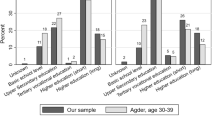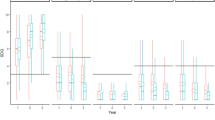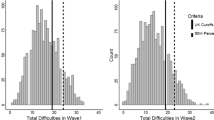Abstract
The objective of the study is to investigate the prevalence, distribution and predictors of mental health problems in 5–7-year-old Danish children in the general population. This study is a 5–7-year follow-up study of a birth cohort of 6,090 children, the Copenhagen Child Cohort 2000. The extended version of the Strengths and Difficulties Questionnaire (SDQ) was answered by parents and pre-school teachers. Data from Danish national registers included perinatal data, socioeconomic data and data on child mental illness diagnosed at hospital in preschool age. Register data from the first year of life was obtained from 99.7% of the children in the cohort. Of 5,898 eligible children, 3,501 participated in the SDQ assessment (59%). The overall estimated 6-month prevalence of mental health problems was 4.8% (95% CI 4.1–5.6). Conduct problems were found in 3.0% (95% CI 2.4–3.6), problems of hyperactivity/inattention in 0.7% (95% CI 0.4–1.0) and emotional problems in 1.5% (95% CI 1.1–1.9). Boys showed a higher risk of having mental health problems as compared to girls: risk ratio 2.0 (95% CI 1.5–2.8). Several markers of socioeconomic disadvantages were associated with mental health problems at 5–7 years of age. In conclusion, the 6-month prevalence of SDQ-measured mental health problems was relatively low in Danish children when compared with findings from several European countries, but was in line with findings from other studies in Nordic countries. The lower prevalence might reflect differences in psychosocial risk load and environmental stress given the social and cultural context.

Similar content being viewed by others
Abbreviations
- SDQ:
-
Strengths and difficulties questionnaire
- DAWBA:
-
Development and well-being assessment
- OR:
-
Odds ratio
- RR:
-
Risk ratio
- CI:
-
Confidence intervals
- P:
-
Parents
- T:
-
Pre-school teachers
References
Costello EJ, Egger H, Angold A (2005) 10-year research update review: the epidemiology of child and adolescent psychiatric disorders: I. methods and public health burden. J Am Acad Child Adolesc Psychiatry 44:972–986
Kessler RC, Berglund P, Demler O, Jin R, Merikangas KR, Walters EE (2005) Lifetime prevalence and age-of-onset distributions of DSM-IV disorders in the National Comorbidity Survey Replication. Arch Gen Psychiatry 62:593–602
Angold A, Egger HL (2007) Preschool psychopathology: lessons for the lifespan. J Child Psychol Psychiatry 48:961–966
Anselmi L, Barros FC, Teodoro ML, Piccinini CA, Menezes AM, Araujo CL, Rohde LA (2008) Continuity of behavioral and emotional problems from pre-school years to pre-adolescence in a developing country. J Child Psychol Psychiatry 49:499–507
Costello EJ, Mustillo S, Erkanli A, Keeler G, Angold A (2003) Prevalence and development of psychiatric disorders in childhood and adolescence. Arch Gen Psychiatry 60:837–844
Costello EJ, Foley DL, Angold A (2006) 10-year research update review: the epidemiology of child and adolescent psychiatric disorders: II. developmental epidemiology. J Am Acad Child Adolesc Psychiatry 45:8–25
Achenbach TM, Becker A, Dopfner M, Heiervang E, Roessner V, Steinhausen HC, Rothenberger A (2008) Multicultural assessment of child and adolescent psychopathology with ASEBA and SDQ instruments: research findings, applications, and future directions. J Child Psychol Psychiatry 49:251–275
Goodman R (1997) The Strengths and Difficulties Questionnaire: a research note. J Child Psychol Psychiatry 38:581–586
Goodman R (1999) The extended version of the Strengths and Difficulties Questionnaire as a guide to child psychiatric caseness and consequent burden. J Child Psychol Psychiatry 40:791–799
Goodman R, Ford T, Simmons H, Gatward R, Meltzer H (2000) Using the Strengths and Difficulties Questionnaire (SDQ) to screen for child psychiatric disorders in a community sample. Br J Psychiatry 177:534–539
Goodman R (2001) Psychometric properties of the strengths and difficulties questionnaire. J Am Acad Child Adolesc Psychiatry 40:1337–1345
Bourdon KH, Goodman R, Rae DS, Simpson G, Koretz DS (2005) The Strengths and Difficulties Questionnaire: US normative data and psychometric properties. J Am Acad Child Adolesc Psychiatry 44:557–564
Heiervang E, Goodman A, Goodman R (2008) The Nordic advantage in child mental health: separating health differences from reporting style in a cross-cultural comparison of psychopathology. J Child Psychol Psychiatry 49:678–685
Meltzer H, Gatward R, Goodman R, Ford T (2000) Mental health of children and adolescents in Great Britain. The Stationery Office, London
Obel C, Heiervang E, Rodriguez A, Heyerdahl S, Smedje H, Sourander A, Guethmundsson OO, Clench-Aas J, Christensen E, Heian F, Mathiesen KS, Magnusson P, Njarethvik U, Koskelainen M, Ronning JA, Stormark KM, Olsen J (2004) The Strengths and Difficulties Questionnaire in the Nordic countries. Eur Child Adolesc Psychiatry 13(Suppl 2):II32–II39
Heiervang E, Stormark KM, Lundervold AJ, Heimann M, Goodman R, Posserud MB, Ullebo AK, Plessen KJ, Bjelland I, Lie SA, Gillberg C (2007) Psychiatric disorders in Norwegian 8- to 10-year-olds: an epidemiological survey of prevalence, risk factors, and service use. J Am Acad Child Adolesc Psychiatry 46:438–447
Skovgaard AM, Olsen EM, Houmann T, Christiansen E, Samberg V, Lichtenberg A, Jorgensen T (2005) The Copenhagen County child cohort: design of a longitudinal study of child mental health. Scand J Public Health 33:197–202
(2005) Youth in mind Goodman R. SDQ—information for researchers and professionals about the Strengths and Difficulties Questionnaire. http://www.sdqinfo.com
Goodman R, Renfrew D, Mullick M (2000) Predicting type of psychiatric disorder from Strengths and Difficulties Questionnaire (SDQ) scores in child mental health clinics in London and Dhaka. Eur Child Adolesc Psychiatry 9:129–134
Obel C, Dalsgaard S, Stax HP, Bilenberg N (2003) Strengths and Difficulties Questionnaire (SDQ-Dan). A new instrument for psychopathologic screening of children aged 4–16 years. Ugeskr Laeger 165:462–465
Rothman KJ, Greenland S (1998) Modern epidemiology, chapter 15., 2nd edn. Lippincott, New York,
Christensen E (2004) The first 7 years of life. The Danish National Centre for Social Research, Copenhagen
Kaptein S, Jansen DE, Vogels AG, Reijneveld SA (2008) Mental health problems in children with intellectual disability: use of the Strengths and Difficulties Questionnaire. J Intellect Disabil Res 52:125–131
Ravens-Sieberer U, Wille N, Erhart M, Bettge S, Wittchen HU, Rothenberger A, Herpertz-Dahlmann B, Resch F, Holling H, Bullinger M, Barkmann C, Schulte-Markwort M, Dopfner M (2008) Prevalence of mental health problems among children and adolescents in Germany: results of the BELLA study within the National Health Interview and Examination Survey. Eur Child Adolesc Psychiatry 17(Suppl 1):22–33
ShojaeiT, Wazana A, Pitrou I, KovessV (2008) The strengths and difficulties questionnaire: validation study in French school-aged children and cross-cultural comparisons. Soc Psychiatry Psychiatr Epidemiol
Petersen DJ, Bilenberg N, Hoerder K, Gillberg C (2006) The population prevalence of child psychiatric disorders in Danish 8- to 9-year-old children. Eur Child Adolesc Psychiatry 15:71–78
Friedman RJ, Chase-Landsdale PL (2002) Chronic adversities. In: Rutter and Taylor (eds) Child and adolescent psychiatry. Oxford Blackwell Science, Oxford, pp 261–276
World Health Organization (2009) Process of translation and adaptation of instruments. http://www.who.int/substance_abuse/research_tools/translation/en/index.html
Acknowledgments
The study was supported by The Copenhagen County Research Foundation (now called The Capital Region of Denmark), The Health Insurance Foundation, Mrs C. Hermansens Memorial Fund, The Foundation of Butcher Max Wørzner and wife, The Psychiatric Foundation of 1967, The Tryg Foundation, The Augustinus Foundation, The Danish Association for Mental Health. Robert Goodman is Director and part owner of Youth in Mind, which provides no-cost software and websites related to the SDQ.
Conflict of interest statement
None.
Author information
Authors and Affiliations
Corresponding author
Rights and permissions
About this article
Cite this article
Elberling, H., Linneberg, A., Olsen, E.M. et al. The prevalence of SDQ-measured mental health problems at age 5–7 years and identification of predictors from birth to preschool age in a Danish birth cohort: The Copenhagen Child Cohort 2000. Eur Child Adolesc Psychiatry 19, 725–735 (2010). https://doi.org/10.1007/s00787-010-0110-z
Received:
Accepted:
Published:
Issue Date:
DOI: https://doi.org/10.1007/s00787-010-0110-z




